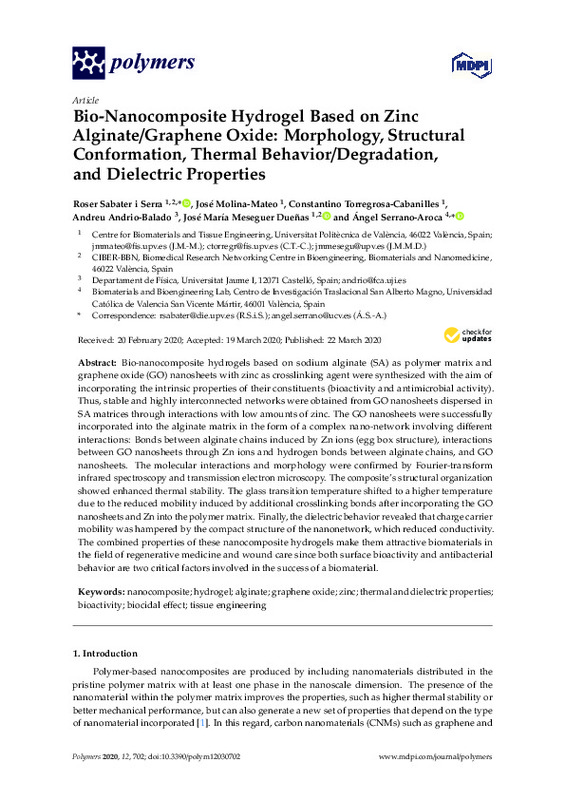JavaScript is disabled for your browser. Some features of this site may not work without it.
Buscar en RiuNet
Listar
Mi cuenta
Estadísticas
Ayuda RiuNet
Admin. UPV
Bio-Nanocomposite Hydrogel Based on Zinc Alginate/Graphene Oxide: Morphology, Structural Conformation, Thermal Behavior/Degradation, and Dielectric Properties
Mostrar el registro completo del ítem
Sabater I Serra, R.; Molina Mateo, J.; Torregrosa Cabanilles, C.; Andrio-Balado, A.; Meseguer Dueñas, JM.; Serrano-Aroca, Á. (2020). Bio-Nanocomposite Hydrogel Based on Zinc Alginate/Graphene Oxide: Morphology, Structural Conformation, Thermal Behavior/Degradation, and Dielectric Properties. Polymers. 12(3):1-16. https://doi.org/10.3390/polym12030702
Por favor, use este identificador para citar o enlazar este ítem: http://hdl.handle.net/10251/176347
Ficheros en el ítem
Metadatos del ítem
| Título: | Bio-Nanocomposite Hydrogel Based on Zinc Alginate/Graphene Oxide: Morphology, Structural Conformation, Thermal Behavior/Degradation, and Dielectric Properties | |
| Autor: | Andrio-Balado, Andreu Serrano-Aroca, Ángel | |
| Entidad UPV: |
|
|
| Fecha difusión: |
|
|
| Resumen: |
[EN] Bio-nanocomposite hydrogels based on sodium alginate (SA) as polymer matrix and graphene oxide (GO) nanosheets with zinc as crosslinking agent were synthesized with the aim of incorporating the intrinsic properties ...[+]
|
|
| Palabras clave: |
|
|
| Derechos de uso: | Reconocimiento (by) | |
| Fuente: |
|
|
| DOI: |
|
|
| Editorial: |
|
|
| Versión del editor: | https://doi.org/10.3390/polym12030702 | |
| Código del Proyecto: |
|
|
| Agradecimientos: |
This research was funded by the Spanish Ministry of Science, Innovations and Universities through the RTI2018-097862-B-C21 Project (including the FEDER financial support). A.S.-A. also acknowledges the Fundacion Universidad ...[+]
|
|
| Tipo: |
|









